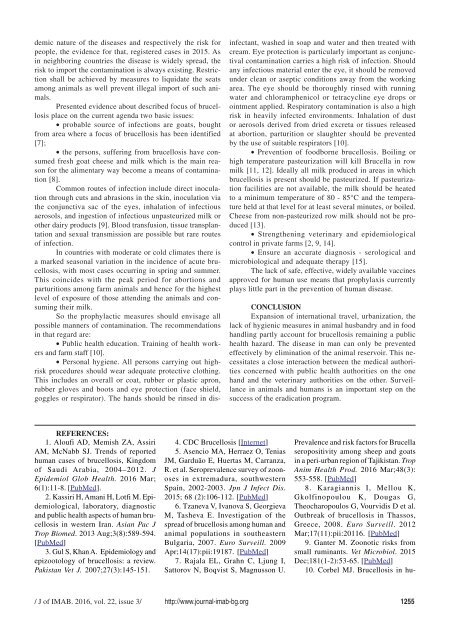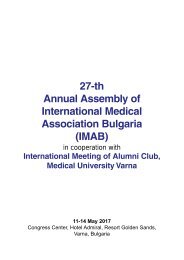JofIMAB-2016-vol22-issue3
You also want an ePaper? Increase the reach of your titles
YUMPU automatically turns print PDFs into web optimized ePapers that Google loves.
demic nature of the diseases and respectively the risk for<br />
people, the evidence for that, registered cases in 2015. As<br />
in neighboring countries the disease is widely spread, the<br />
risk to import the contamination is always existing. Restriction<br />
shall be achieved by measures to liquidate the seats<br />
among animals as well prevent illegal import of such animals.<br />
Presented evidence about described focus of brucellosis<br />
place on the current agenda two basic issues:<br />
• probable source of infections are goats, bought<br />
from area where a focus of brucellosis has been identified<br />
[7];<br />
• the persons, suffering from brucellosis have consumed<br />
fresh goat cheese and milk which is the main reason<br />
for the alimentary way become a means of contamination<br />
[8].<br />
Common routes of infection include direct inoculation<br />
through cuts and abrasions in the skin, inoculation via<br />
the conjunctiva sac of the eyes, inhalation of infectious<br />
aerosols, and ingestion of infectious unpasteurized milk or<br />
other dairy products [9]. Blood transfusion, tissue transplantation<br />
and sexual transmission are possible but rare routes<br />
of infection.<br />
In countries with moderate or cold climates there is<br />
a marked seasonal variation in the incidence of acute brucellosis,<br />
with most cases occurring in spring and summer.<br />
This coincides with the peak period for abortions and<br />
parturitions among farm animals and hence for the highest<br />
level of exposure of those attending the animals and consuming<br />
their milk.<br />
So the prophylactic measures should envisage all<br />
possible manners of contamination. The recommendations<br />
in that regard are:<br />
• Public health education. Training of health workers<br />
and farm staff [10].<br />
• Personal hygiene. All persons carrying out highrisk<br />
procedures should wear adequate protective clothing.<br />
This includes an overall or coat, rubber or plastic apron,<br />
rubber gloves and boots and eye protection (face shield,<br />
goggles or respirator). The hands should be rinsed in disinfectant,<br />
washed in soap and water and then treated with<br />
cream. Eye protection is particularly important as conjunctival<br />
contamination carries a high risk of infection. Should<br />
any infectious material enter the eye, it should be removed<br />
under clean or aseptic conditions away from the working<br />
area. The eye should be thoroughly rinsed with running<br />
water and chloramphenicol or tetracycline eye drops or<br />
ointment applied. Respiratory contamination is also a high<br />
risk in heavily infected environments. Inhalation of dust<br />
or aerosols derived from dried excreta or tissues released<br />
at abortion, parturition or slaughter should be prevented<br />
by the use of suitable respirators [10].<br />
• Prevention of foodborne brucellosis. Boiling or<br />
high temperature pasteurization will kill Brucella in row<br />
milk [11, 12]. Ideally all milk produced in areas in which<br />
brucellosis is present should be pasteurized. If pasteurization<br />
facilities are not available, the milk should be heated<br />
to a minimum temperature of 80 - 85°C and the temperature<br />
held at that level for at least several minutes, or boiled.<br />
Cheese from non-pasteurized row milk should not be produced<br />
[13].<br />
• Strengthening veterinary and epidemiological<br />
control in private farms [2, 9, 14].<br />
• Ensure an accurate diagnosis - serological and<br />
microbiological and adequate therapy [15].<br />
The lack of safe, effective, widely available vaccines<br />
approved for human use means that prophylaxis currently<br />
plays little part in the prevention of human disease.<br />
CONCLUSION<br />
Expansion of international travel, urbanization, the<br />
lack of hygienic measures in animal husbandry and in food<br />
handling partly account for brucellosis remaining a public<br />
health hazard. The disease in man can only be prevented<br />
effectively by elimination of the animal reservoir. This necessitates<br />
a close interaction between the medical authorities<br />
concerned with public health authorities on the one<br />
hand and the veterinary authorities on the other. Surveillance<br />
in animals and humans is an important step on the<br />
success of the eradication program.<br />
REFERENCES:<br />
1. Aloufi AD, Memish ZA, Assiri<br />
AM, McNabb SJ. Trends of reported<br />
human cases of brucellosis, Kingdom<br />
of Saudi Arabia, 2004–2012. J<br />
Epidemiol Glob Health. <strong>2016</strong> Mar;<br />
6(1):11-8. [PubMed].<br />
2. Kassiri H, Amani H, Lotfi M. Epidemiological,<br />
laboratory, diagnostic<br />
and public health aspects of human brucellosis<br />
in western Iran. Asian Pac J<br />
Trop Biomed. 2013 Aug;3(8):589-594.<br />
[PubMed]<br />
3. Gul S, Khan A. Epidemiology and<br />
epizootology of brucellosis: a review.<br />
Pakistan Vet J. 2007;27(3):145-151.<br />
4. CDC Brucellosis [Internet]<br />
5. Asencio MA, Herraez O, Tenias<br />
JM, Garduão E, Huertas M, Carranza,<br />
R. et al. Seroprevalence survey of zoonoses<br />
in extremadura, southwestern<br />
Spain, 2002-2003. Jpn J Infect Dis.<br />
2015; 68 (2):106-112. [PubMed]<br />
6. Tzaneva V, Ivanova S, Georgieva<br />
M, Tasheva E. Investigation of the<br />
spread of brucellosis among human and<br />
animal populations in southeastern<br />
Bulgaria, 2007. Euro Surveill. 2009<br />
Apr;14(17):pii:19187. [PubMed]<br />
7. Rajala EL, Grahn C, Ljung I,<br />
Sattorov N, Boqvist S, Magnusson U.<br />
Prevalence and risk factors for Brucella<br />
seropositivity among sheep and goats<br />
in a peri-urban region of Tajikistan. Trop<br />
Anim Health Prod. <strong>2016</strong> Mar;48(3):<br />
553-558. [PubMed]<br />
8. Karagiannis I, Mellou K,<br />
Gkolfinopoulou K, Dougas G,<br />
Theocharopoulos G, Vourvidis D et al.<br />
Outbreak of brucellosis in Thassos,<br />
Greece, 2008. Euro Surveill. 2012<br />
Mar;17(11):pii:20116. [PubMed]<br />
9. Ganter M. Zoonotic risks from<br />
small ruminants. Vet Microbiol. 2015<br />
Dec;181(1-2):53-65. [PubMed]<br />
10. Corbel MJ. Brucellosis in hu-<br />
/ J of IMAB. <strong>2016</strong>, vol. 22, issue 3/ http://www.journal-imab-bg.org 1255



